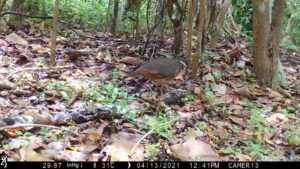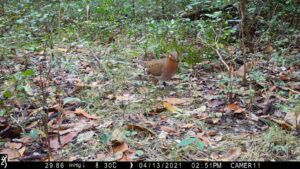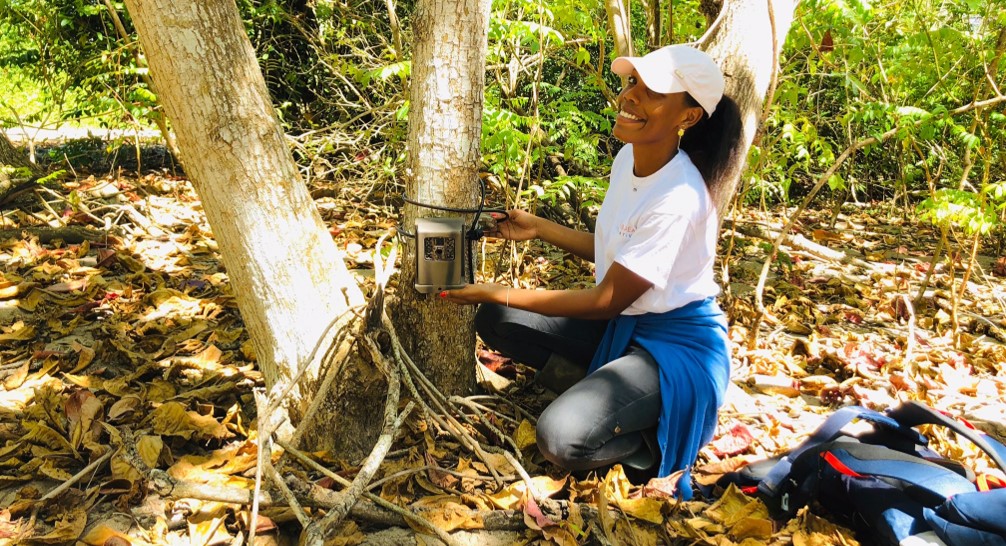Pigeons and doves play a crucial role in the dynamics and diversity of many ecosystems, thanks to their ability to disperse seeds. Their decline could therefore affect other species, including both animals and plants. In the insular Caribbean, data on columbid species are still scarce. In a recent study, camera-traps were used to learn more about three avian species.
Guadeloupe is home to several species of doves, such as the Ruddy Quail-Dove (Geotrygon montana), the Bridled Quail-Dove (Geotrygon mystacea), or the Zenaida Dove (Zenaida aurita). These three species, which feed on the ground mainly from seeds and fruits fallen from trees, are not considered as threatened on a global scale. However, their populations are reported to be declining, especially in the Caribbean islands.
To know their conservation status, but also to better understand the lifestyles of these species and the threats that they face, Aurélie Jean-Pierre set up an arsenal of camera traps in the field. After selecting 24 sites throughout the territory, scattered in several different ecosystems (dry forests, tropical rainforests and flooded forests including mangroves and swamp forests), she placed 5 cameras in each one. Cameras were attached to tree trunks, about twenty centimetres above the ground, to automatically photograph any animal passing in front of it, day and night, 24 hours a day, during two sessions each lasting a full week.

Bridled Quail-Dove (Geotrygon mystacea)
During the two trapping sessions carried out at each site, nearly 10,000 images were captured, showing many different species including 351 Bridled Quail-Doves, 198 Zenaida Doves and only 14 Ruddy Quail-Doves. Data analysis led to a better understanding of the abundance of these species and their preference for different types of ecosystems: while Bridled Quail-Doves showed a preference for tropical rainforests, Zenaida Doves photographed more often in dry forests and flooded forests. Some parameters measured in the field also played a role: Zenaida Doves showed a preference for open environments, with a sparse canopy, while high temperatures negatively affected Bridled Quail-Doves, a worrying result in the actual context of global warming.
The many other species photographed also bring interesting information. Indeed, Guadeloupe hosts many invasive exotic species, including potential predators for columbid birds: small Indian mongooses, rats, raccoons, domestic cats and dogs. The researchers were able to determine the spatial and temporal co-occurrence of these species with the doves, and to understand which predators pose a risk for each of the species studied. The presence of mongooses, cats and dogs in forest habitats is particularly concerning.

Zeinada Dove (Zenaida aurita)
The use of camera traps is an effective study method that has several advantages over other methods. Indeed, it can be difficult to visually observe birds, especially species with a stealthy nature, in dense forests. Capturing birds with nets is very effective to estimate demographic parameters but requires a significant effort in terms of logistics. For conservation purposes, the authors thus encourage the use of camera traps on a regular and widespread basis in other islands, in order to better understand the demographic parameters of these species on a larger scale.
References
Jean-Pierre, A., Loranger-Merciris, G., Cézilly, F. (2022). Spatial occupancy, local abundance and activity rhythm of three ground dwelling columbid species in the forests of Guadeloupe in relation to environmental factors. Diversity, 14, 480.
About the author
Aurélie Jean-Pierre is currently pursuing her doctorate research at the Université des Antilles (Guadeloupe), under the supervision of Dr. Gladys Loranger-Merciris and Pr. Frank Cézilly. Her research on the impact of environmental factors on the presence and relative abundance of several species of birds is co-financed by the Ministry of Higher Education, the NGO Caribaea Initiative and the Office Français de la Biodiversité (OFB).

